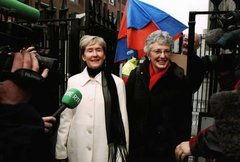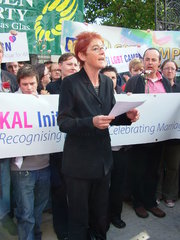History of Marriage Equality
Marriage Equality is a not for profit, national, single issue, grassroots advocacy organisation whose goal is to achieve equality for lesbian, gay, bisexual and transgender (LGBT) people in Ireland through the extension of civil marriage rights to same-sex couples.
 Marriage Equality was launched in February 2008. It grew from the KAL Advocacy Initiative: a case to recognise the Canadian marriage of two Irish citizens - Drs Katherine Zappone and Ann Louise Gilligan. (left, outside the High Court in 2006)
Marriage Equality was launched in February 2008. It grew from the KAL Advocacy Initiative: a case to recognise the Canadian marriage of two Irish citizens - Drs Katherine Zappone and Ann Louise Gilligan. (left, outside the High Court in 2006)
The campaign's timing followed from a number of inter-related events. In 2006, the High Court found that although the Irish Constitution did not define marriage as between a man and a woman, it was implied, and therefore there was no breach of rights when the Irish Revenue Commissioners' refused to recognise Katherine and Ann Louise's Canadian marriage. Despite losing in the High Court, the case was widely seen as an enormous success, raising awareness about the need for marriage equality for same-sex couples in the media, legal and political spheres as well as winning hearts and minds amongst the general public.
 Ailbhe Smyth, Marriage Equality Board Member, addresses Dail rally for LGBT rightsTwo reports published in 2006 were also relevant to the rights of same-sex couples: the Law Reform Commission's report on the rights and duties of co-habitants (heterosexual and same-sex), and findings of an all-party parliamentary Committee on the Constitution that reported in favour of legal recognition of same-sex relationships for 'marriage-like' privileges.
Ailbhe Smyth, Marriage Equality Board Member, addresses Dail rally for LGBT rightsTwo reports published in 2006 were also relevant to the rights of same-sex couples: the Law Reform Commission's report on the rights and duties of co-habitants (heterosexual and same-sex), and findings of an all-party parliamentary Committee on the Constitution that reported in favour of legal recognition of same-sex relationships for 'marriage-like' privileges.
In tandem with these developments, the Irish Government set up the Colley Group. This working group in the Department of Justice, Equality and Law Reform set out options in relation to how the Irish State should treat domestic partners / cohabiting couples.
The outcome of these deliberations, the Colley Report (2006), found that while marriage equality was the only true equality measure, civil partnership was likely to be the only option through legislation, as same-sex civil marriage could possibly require a change to the Irish Constitution (which would require a national referendum).
Marriage Equality shares the view of many respected lawyers that a constitutional referendum is not needed in order to legislate for equality.
Marriage Equality held, and continues to hold, the view that the Civil Partnership Bill (now the Civil Partnership Act) did not represent what the vast majority of lesbian and gay people wanted, as the Bill fell short of affording same sex couples the same rights as heterosexual citizens. Marriage Equality argued that a national campaign was required to bring about civil marriage for same-sex couples in Ireland.
"The Government's position of providing lesser rights, compared to marriage, seriously undermines the principle of equality. Equality is not something that can be introduced in a piecemeal basis or a partial basis." (Marriage Equality campaign, 2008)
For a more detailed look at the history and development of Marriage Equality, please see our Case Study (by Dr Ide O'Carroll, O'Carroll Associates and Finbar McDonnell, Hibernian Consulting)



 Marriage Equality is a proud member of NELFA
Marriage Equality is a proud member of NELFA